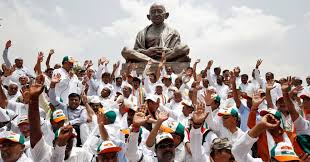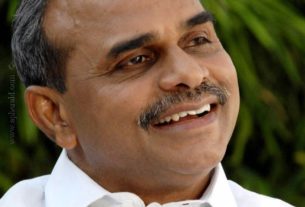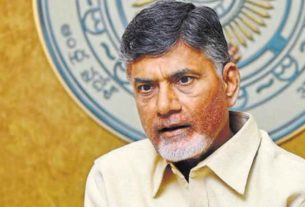The theme of the 16th edition of the India conference is ‘India at an inflection point’. As the organisers of this magnificent event have put it, this has been an often-used term about India for almost a decade now. But, as they say, there is no better time than today when the largest democracy is going to vote in a couple of months.
To any keen observer of India, it is quite evident that the country is at the crossroads today. The general elections to be held during April-May this year are already generating much heat. The battle-lines are being drawn between the BJP and allies on the one hand and the main opposition Congress and regional parties on the other. Prime Minister Narendra Modi has already begun campaigning in the opposition-ruled States and Rahul Gandhi-led Congress and the regional satraps have launched a blistering counter-offensive against the BJP. What is at stake in these general elections is not merely a mandate to run the country for the next five years but the very future in terms of direction of this great civilisation in the forthcoming decades.
If the BJP-led NDA gets to retain power, it would mean that the saffron party would have the power to pursue its Hindutva-driven agenda more aggressively and put the country and its democratic polity on a new trajectory different from what was envisaged by the founding fathers of Indian Constitution seven decades ago. But, if the Congress and like-minded regional parties together get the numbers to wrest power from the NDA, they would have a much tougher task of not only providing a stable government but also checkmating the rise of forces that would like India to be a Hindu Rashtra.
However, one thing is clear. The ensuing elections would turn out to be most bitterly fought polls in contemporary India, because in their no-holds-barred fight, the rival parties and their leaders are likely to convert the campaigning into a boisterous, personalised slugfest. The strategy of these parties would be to lure voters with more ‘attractive’ promises on the one hand and besmirch the reputations of their rivals on the other. The print and electronic media, as well as the social media, would be used more blatantly in this electoral war.
A fleeting glance at Indian politics over the last 35 years in the post-Indira Gandhi era would show that the Indian voters are much smarter than their politicians. In December 1984, in the wake of the then Prime Minister Indira Gandhi’s assassination, the Congress led by her son Rajiv Gandhi won an unprecedented mandate—415 seats and a vote share of 49 percent.
But, by the next general elections in 1989, Rajiv Gandhi had literally squandered much of this goodwill through acts of omission and commission. The list of his controversial actions included Sant Longowal-Rajiv Accord, Assam accord, legislation to undo the Supreme Court verdict in Shah Bano case, despatch of Indian Peace-Keeping Force to Sri Lanka, unlocking of the Babri Masjid and subsequent Shilanyas at Ram Janma Bhoomi site and the Bofors scam.
Though the Congress had emerged as the single largest party in 1989 polls, it had to cede power to a ragtag Janata Dal coalition called as National Front, propped up by the BJP on the one hand and the Left parties on the other, under VP Singh’s stewardship. Implementation of OBC reservations based on Mandal Commission recommendations and Rath Yatra organised by L K Advani on Ram Janma Bhoomi issue led to the fall of the National Front government. The Congress propped up a new government by a splinter group led by Chandrasekhar but within months, the indiscretion of posting few IB personnel at the residence of Rajiv Gandhi cost him the coveted post.
This led to the snap elections in 1991 and, during the course of the polls, Rajiv Gandhi was assassinated. This resulted in the Congress again emerging as single largest party and it was able to form a minority government with P V Narasimha Rao at the helm. Through means fair and foul, Narasimha Rao provided a relatively stable government, brought the country back from financial brink and initiated the economic reforms. Also, it was during his reign that the Babri Masjid was demolished in Ayodhya, leading to large-scale communal violence across the country.
Still, with its dwindling numbers secured in the 1996 general elections, the Congress was able to prop up two prime ministers—H D Deve Gowda and I K Gujral under the aegis of United Front, after the first BJP ministry led by Atal Bihari Vajpayee quit within 13 days without facing a vote of confidence. After Congress pulled the rug, Gujral had to order mid-term polls in 1998.
The 1998 elections saw a turnaround in the fortunes of the BJP which was able to form a coalition government with the support of post-poll allies under the banner of National Democratic Alliance. The Vajpayee government fell in 1999 when it lost a trust vote by just one vote after the AIADMK led by Jayalalithaa withdrew support. Kargil war and sympathy for Vajpayee saw the BJP retaining power in 1999 elections with the support of its allies. But, despite its claims of Indian shining and feel-good factor, the NDA lost power in 2004 elections which were called months ahead of the end of the five-year tenure of the Lok Sabha.
The Congress staged a comeback as single largest party and formed the first UPA government with some post-poll allies in 2004. In the 2009 general elections, the Congress improved its tally and retained power with the support of its poll allies. However, over the 10-year period, the country was afflicted with economic ups-and-downs on the one hand and a series of big scams on the other. The economic downturn, coupled with rising prices and less employment opportunities, created a situation where the people began to doubt the ability of the UPA government to revive and sustain the economic growth. This disenchantment of the people provided a god-send opportunity to the BJP to make a determined bid to grab power in the 2014 general elections.
In this backdrop, BJP worked out an elaborate strategy to catapult the party into power. Projecting the then Gujarat Chief Minister Narendra Modi as a “strong contender” for PM’s post vis-a-vis the apparently meek Dr Manmohan Singh was part of this strategy. The BJP also exploited the people’s disenchantment with regional and caste-based parties in various states to shore up its support base and transcend the sub-regional and caste barriers.
In a way, the BJP foresaw the 2014 general elections as a repeat of 1996 and 1998 general elections when the party could capitalize on the failures of other parties and drum up support of various castes, particularly OBCs and Dalits. The pre- and post-Babri demolition poll strategies were replicated to polarize the voters on communal lines. Muzaffarnagar riots and other communal flare-ups elsewhere drove a wedge between the two communities, much to the electoral advantage of BJP.
There was a saffron wave in favour of BJP and its few allies in the 2014 general elections. BJP made a landslide sweep across north, central and western India and won 282 seats. This was almost after three decades that a party could secure majority on its own. The Congress was reduced to its lowest-ever tally of 44 seats and various regional parties got a severe drubbing and some of them drew a blank. Only the regional parties in eastern and southern India, particularly in West Bengal, Odisha, Tamil Nadu and Telangana, remained unaffected by the saffron wave. Smaller parties, apart from its four major allies—Shiv Sena, Akali Dal, Lok Janashakti Party and Telugu Desam– reaped rich dividends from their alliance with BJP.
It was back to the pre-mandal era of upper caste-based politics in Uttar Pradesh, Bihar and other northern, central and western states. The OBC and Dalit parties, which held power for over two decades (since 1994) in Uttar Pradesh and Bihar, forfeited their goodwill among the people due to rampant corruption, casteism, maladministration and deteriorating law and order. Thus, it was as much a negative vote against the Congress and other non-BJP parties as it was a positive vote for the BJP and allies.
BJP’s plank of development, strong leadership and political stability, coupled with the undercurrents of its Hindutva ideology and polarization against minorities, helped the party to create a monolithic vote-bank of the majority community in the Hindi belt as well as adjoining regions. In the assembly elections held after the 2014 general elections, BJP wrested power from the Congress or regional parties in many States.
At the same time, there has been lot of churning in the political scenario in the country in the last five years. In the last couple of years, especially, BJP found it expedient to push its Hindutva agenda. After its landslide victory in Uttar Pradesh polls, Yogi Adityanath was made Chief Minister of India’s largest State. The BJP-led central government resorted to demonetisation in November 2016, implemented GST in the country from July 2017 and brought controversial legislations such as Triple Talaq Bill, Citizenship Amendment Bill and the Constitution (124th Amendment) Bill to extend 10 percent reservations to economically weaker sections.
In recent times, the CBI, Enforcement Directorate, Income Tax Department and other agencies have raked up old cases and raided or interrogated politicians and others connected with political parties opposed to BJP. Elsewhere, in BJP-ruled States, the law-makers of the ruling party, including Union ministers, Chief Ministers, State ministers, MPs, MLAs, MLCs and other functionaries, have resorted to verbal communal rampage with their provocative statements against the minorities. The country has been witnessing a rash of narrow nationalism with all those opposed to BJP or Hindutva ideology dubbed as anti-nationals.
In the states, rabid communal elements have too often taken the law into their hands, resorting to mob lynchings in the name of Gau raksha or Love Jihad. BJP ruled States have closed down slaughter houses. There has been a spurt in atrocities against Dalits (Scheduled Castes), Adivasis (Scheduled Tribes), Minorities and even the Other Backward Castes. There has been an alarming jump in crimes against women, including minor girls and orphans. In Uttar Pradesh, there has been a spike in encounters staged by the police against alleged gangsters.
The BJP, and its ideological progenitor, the Rashtriya Swayamsevak Sangh, and other outfits of Sangh Parivar, such as Vishwa Hindu Parishad and Bajrang Dal, have been making attempts to revive the Mandir-Masjid issue by seeking to fast-track the launch of the construction work of Ram Mandir at Ayodhya. They even tried to put pressure on BJP government to promulgate an ordinance on the temple issue even as the matter is sub-judice and pending adjudication in the Supreme Court. There was mobilisation of thousands of devotees in Ayodhya by VHP, RSS, Shiv Sena and related organisations recently to force an early decision by the Prime Minister on the issue.
To independent observers, it would appear that under the BJP dispensation at the Centre and in the States, inclusive politics and inclusive economics have taken a beating, with even the Congress and some regional parties resorting to “soft Hindutva” in a bid to beat the BJP at its own game. In some States, the opposition parties are keeping silence in the wake of politics of intimidation pursued by the pro-Hindutva elements. Many rationalists, scholars and writers have been threatened, beaten or killed. Universities such as JNU and University of Hyderabad have witnessed turmoil due to the wrath of the right-wing students. In some BJP-ruled States, the liberals and civil liberties and human rights activists faced a crack-down by the state police after being dubbed as “urban Maoists.”
In this scenario, the general elections to elect the 17th Lok Sabha are being held at a crucial and critical juncture in Indian politics. There seems to be disenchantment against the present dispensation at the Centre and in the States among Dalits, Adivasis, Minorities and sections of OBCs. The lower and middle classes are not enthused either, due to the adverse impact of demonetisation and introduction of GST on the one hand, and rising prices and widespread unemployment on the other. The scams in the banking and industrial sector in the last couple of years have dented the BJP’s poll promise of curbing corruption and financial wrongdoing.
There is palpable churning that seems to be slowly turning the tide against the present ruling dispensation. But, those in the opposition ranks—including Congress and many of the regional parties—do not have much to offer to the common man in terms of commitment to democratic and secular ideals and efficient and corruption-free administration. The ensuing elections are being fought as much on national issues as on state and local issues and the outcome will be based on the trends in the states in the absence of any nationwide “wave” conditions. It is a non-holds-barred fight between Mr Narendra Modi and Mr Rahul Gandhi with many regional satraps sniping at both. The regional parties may have the last laugh, at the expense of both the national parties. Let us wait for the voters’ preference on who would be the next Prime Minister without hazarding our own guess.



